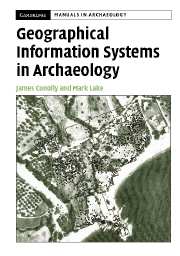Book contents
- Frontmatter
- Contents
- List of figures
- List of tables
- List of boxes
- Acknowledgements
- 1 INTRODUCTION AND THEORETICAL ISSUES IN ARCHAEOLOGICAL GIS
- 2 FIRST PRINCIPLES
- 3 PUTTING GIS TO WORK IN ARCHAEOLOGY
- 4 THE GEODATABASE
- 5 SPATIAL DATA ACQUISITION
- 6 BUILDING SURFACE MODELS
- 7 EXPLORATORY DATA ANALYSIS
- 8 SPATIAL ANALYSIS
- 9 MAP ALGEBRA, SURFACE DERIVATIVES AND SPATIAL PROCESSES
- 10 REGIONS: TERRITORIES, CATCHMENTS AND VIEWSHEDS
- 11 ROUTES: NETWORKS, COST PATHS AND HYDROLOGY
- 12 MAPS AND DIGITAL CARTOGRAPHY
- 13 MAINTAINING SPATIAL DATA
- Glossary
- References
- Index
2 - FIRST PRINCIPLES
Published online by Cambridge University Press: 05 June 2012
- Frontmatter
- Contents
- List of figures
- List of tables
- List of boxes
- Acknowledgements
- 1 INTRODUCTION AND THEORETICAL ISSUES IN ARCHAEOLOGICAL GIS
- 2 FIRST PRINCIPLES
- 3 PUTTING GIS TO WORK IN ARCHAEOLOGY
- 4 THE GEODATABASE
- 5 SPATIAL DATA ACQUISITION
- 6 BUILDING SURFACE MODELS
- 7 EXPLORATORY DATA ANALYSIS
- 8 SPATIAL ANALYSIS
- 9 MAP ALGEBRA, SURFACE DERIVATIVES AND SPATIAL PROCESSES
- 10 REGIONS: TERRITORIES, CATCHMENTS AND VIEWSHEDS
- 11 ROUTES: NETWORKS, COST PATHS AND HYDROLOGY
- 12 MAPS AND DIGITAL CARTOGRAPHY
- 13 MAINTAINING SPATIAL DATA
- Glossary
- References
- Index
Summary
Introduction
The power of GIS, as with other computer programs, can be deceptive: visually impressive but ultimately meaningless results can appear unassailable because of the sophisticated technologies used to produce them (Eiteljorg 2000). The familiar adage ‘garbage in, garbage out’ is particularly applicable to GIS, and one of our primary aims throughout this book is to provide guidance on how to use this technology in ways to strengthen and extend our understanding of the human past, rather than to obfuscate it. In this chapter we start by providing an overview of the ‘first principles’ of GIS: the software and hardware requirements, geodetic and cartographic principles, and GIS data models. These provide the conceptual building blocks that are essential for understanding what GIS is, how it works, and what its strengths and limitations are. Although some of these ‘first principles’ may be familiar to readers who are experienced in cartography and computer graphics, we nevertheless provide a thorough review of each as they yield the foundation on which we build in later chapters.
The basics
GIS functionality
What does a GIS do? Simply providing a definition of GIS and referring to its abilities to capture and manipulate spatial data doesn't provide much insight into its functionality. More informative is to break some of the basic tasks of a GIS into five groups: data acquisition, spatial data management, database management, data visualisation and spatial analysis.
- Type
- Chapter
- Information
- Geographical Information Systems in Archaeology , pp. 11 - 32Publisher: Cambridge University PressPrint publication year: 2006

